Contemporary artist Emily Hartley-Skudder talks about her fascination with the ‘artificial ordinary.’ In an interview with Sonalee Tomar, she elaborates on the process of using a blend of the real and artificial to create still life that help people notice things around them a little more.
Alongside inescapable art historical references, I hope to mix ingredients of humour, feminism, taste and desire, perhaps offering a playful subversion of a historically male-dominated art world.
Contemporary artist Emily Hartley-Skudder
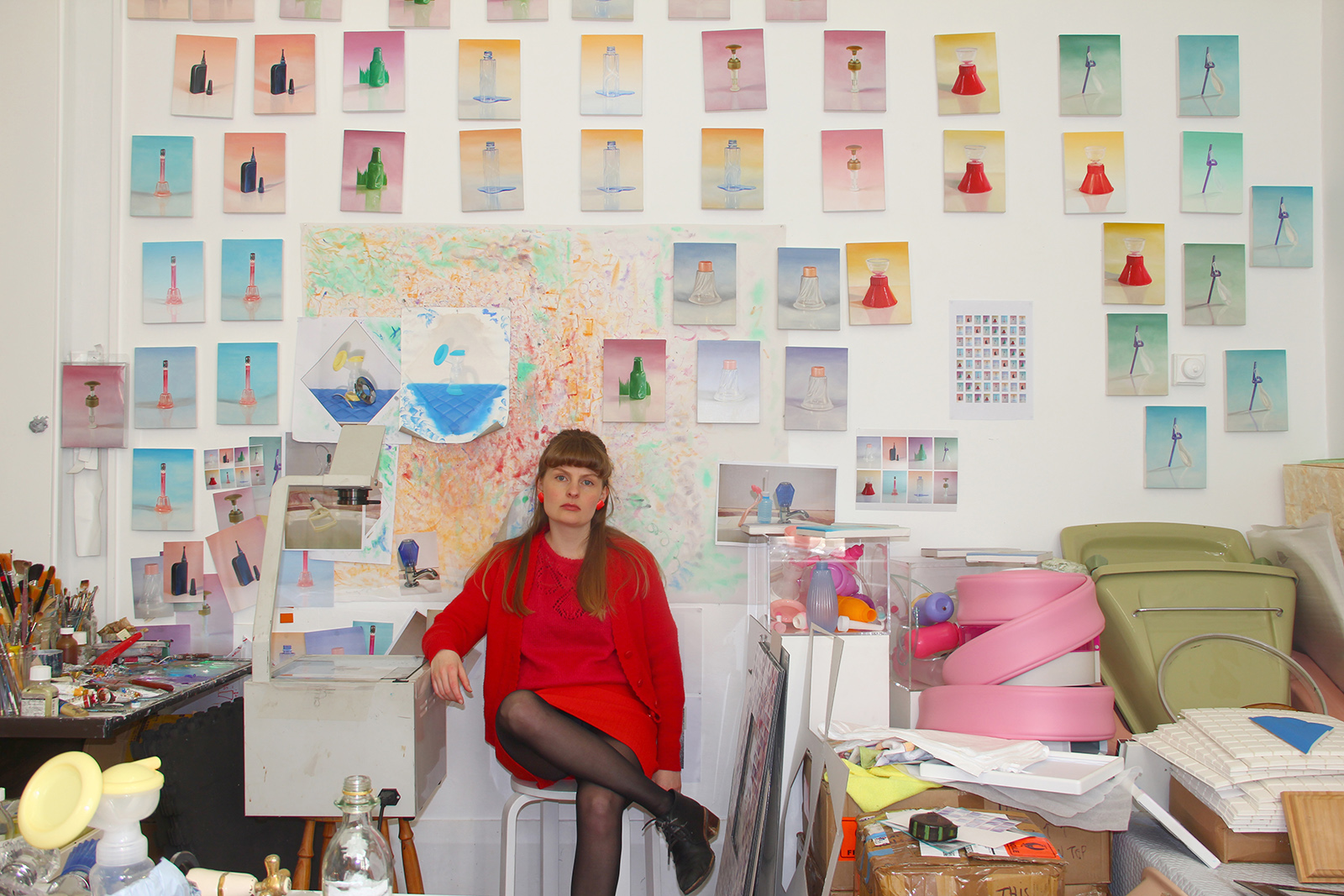
Contemporary artist Emily Hartley-Skudder. Self Portrait in the studio with ‘Fancy Goods’, 2019.
Take us to the beginning of your story. How did your tryst with art begin?
I’ve always loved making and collecting things – sometimes to an obsessive degree. Throughout my childhood, I collected miniatures and as an only child, I was lucky enough to have a family that indulged my obsession – passing on doll houses from cousins and buying me new additions on birthdays. I made tiny furniture, clothing, food and decorated the houses, living in this alternate world. I found that tiny replicas of the commonplace invite us to project our fantasies onto them; we can shrink down to their size and escape into a different reality. This lead to seeing commercial showhomes as life-sized doll houses. I was drawn to the synthetic homeliness of kitchen and bathroom showrooms, theatre and film sets and museum dioramas. All this is where my fascination with the ‘artificial ordinary’ began. Why do we have a preoccupation with recreating aspects of our everyday lives?
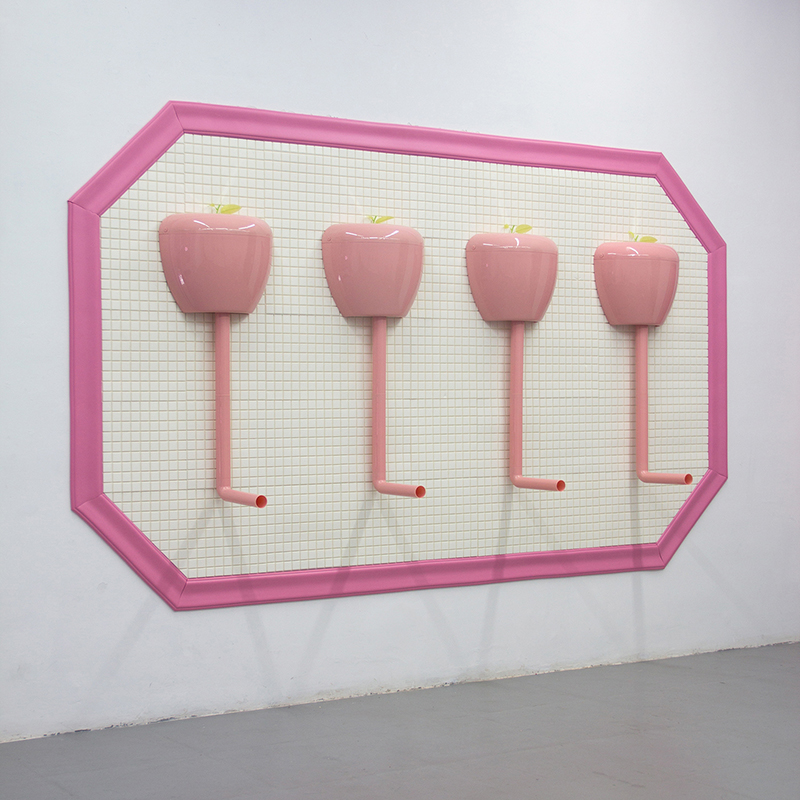
Pipe Dreams, 2018, CEAC Gallery, Xiamen, China. Contemporary artist Emily Hartley-Skudder.
Tell us about the evolution of your practice over the years.
I pulled out all of my miniatures years later, set them up and started photographing inside the rooms of the doll houses. I loved that you could use the camera’s lens to shrink down into these tiny environments. There was something significant about using photography – which has been largely interpreted as capturing observable fact – to make images of things that are fake. There was a thrill in the brief deception, when the scene gradually separates from its initial reading as viewers realise the artifice.
I thought a lot about how this created a feeling of the uncanny. When you take something very ordinary and change it slightly, it can become familiarly strange. I looked at artists like David Levinthal and Laurie Simmons, where miniatures and toys were exposed as socialisation devices for children, and thought about how playing with doll houses as a child had been prepping me to become a homemaker in ‘real life’ as an adult. I’ve very much resisted this, while I continue to play with my fake domestic objects in the studio.
At art school, I realised the whole ‘constructing realities’ through photography had of course been thoroughly explored, so I wanted to see if I could create a similar response with paint. What happens if I paint from my photographs ‘realistically’ and reference the photographic depth of field? Would the image still be anchored in some form of reality, so the play between real and artificial could translate?
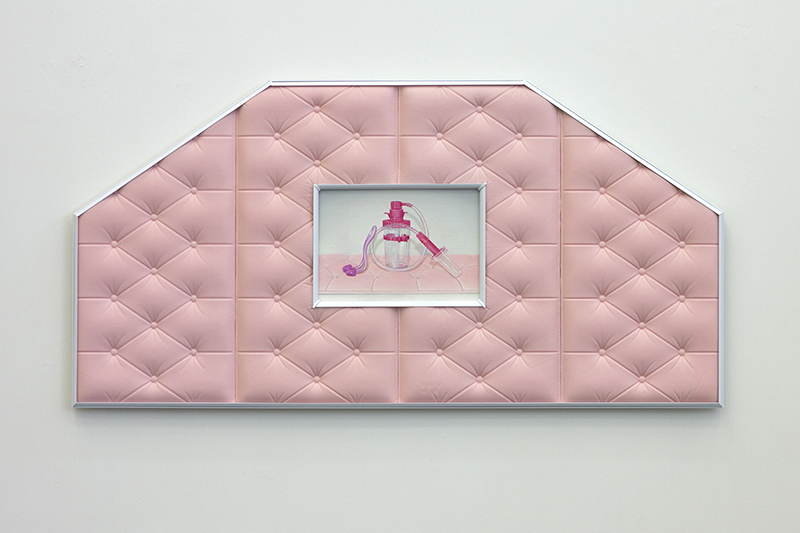
Gobstopper, 2019. Contemporary artist Emily Hartley-Skudder.
I honed in on the still life, collecting more miniatures, fake flowers, fruit and plastic objects, arranging, photographing and translating the photographs into paintings. I relished the fact that the historic still life was considered ‘unheroic’ and the lowest genre in the hierarchy of painting, which meant it was also the only appropriate genre for the female painter. Love that the historic still life often depicted patrons’ prized possessions, with the painting then being hung among those same items to decorate the domestic space. This is the kind of doubling that I’m so fascinated with.
The still life is pervasive; it is one of the most common domestic decorations. It has travelled a trajectory through time, from the dark, moralistic Vanitas of the 16th and 17th centuries through to kitschy, colourful home styling manuals, cookbooks and wall-fillers of the 20th. I enjoy the cheeky reference to artworks as décor; paintings to match the couch and kitchen. This is the consumerist culture that no one can escape!
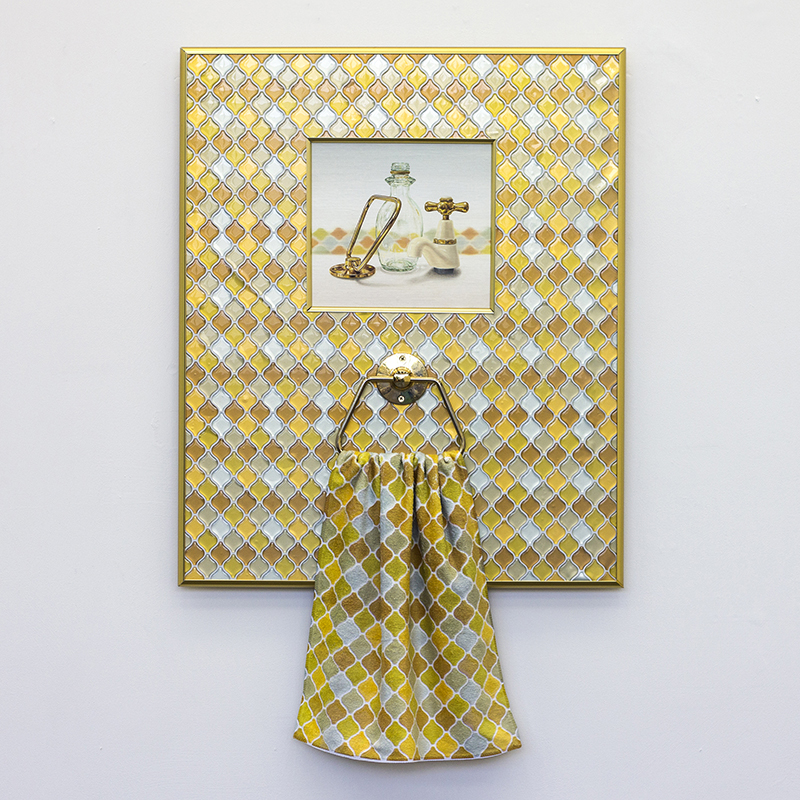
Sparking Duet, 2019. Contemporary artist Emily Hartley-Skudder.
What inspires you? Take us through your process and continuous frameworks of reference.
Having a painting practice as a foundation, I am interested in how paintings sit within a space and interact with their environment. I am increasingly excited about installation and readymade sculpture, as so much of my process begins with searching and collecting found objects. I am constantly looking at material culture to get new ideas. Love responding to objects and spaces, creating my own showrooms and life-sized doll houses as installations. I draw from decorative and ‘stock’ imagery and I think a lot about ‘kitsch’ as being a kind of nostalgic commodification.
My search for miniatures, toys and plastic receptacles has expanded into cosmetics, bathroom sinks and taps, breast pumps and snake-oil feminine hygiene tools. I collect coloured carpet, tiles and cheap home décor wall coverings, like imitation leather and lino. And I come at my work with a feminine and feminist lens, using domestic subject matter and bright or pastel colours to challenge why certain aesthetics are considered ‘stronger’ and more ‘serious’. I enjoy combining the peculiar with the banal, blurring what could be suspiciously pleasant or sexually suggestive. Alongside inescapable art historical references, I hope to mix ingredients of humour, feminism, taste and desire, perhaps offering a playful subversion of a historically male-dominated art world.

Mrs Powder Fresh, 2018. Contemporary artist Emily Hartley-Skudder.
What were your biggest learnings and hiccups along the way?
The relationships you have with others around your practice can be tricky – especially with art dealers, as their motivations can be rather different from your own. As a young artist, I began working with a self-assured, sometimes forceful art dealer. I found myself being convinced to do a couple of commissions I wasn’t particularly excited about and more exhibitions and commitments than was sustainable, which left me burnt out and questioning whether I wanted to be an artist. Felt like I had lost my autonomy and was stuck inside a commercial model which didn’t give me space to develop my work in the ways I wanted.
I was locked into a contract and the relationship began to break down, and I began resenting the gallery I was with. But I also had had a taste of selling almost everything I made at the time, which seemed amazing in terms of sustaining my practice financially. This also gave me a bit of false hope in terms of the realities of being an artist, as things don’t often last! I’ve come a long way now towards accepting there will always be ups and downs, with compromises and part-time jobs. But I think it’s worth it. I’ve learnt to know my limits, choose carefully who I work with and stay true to my practice.
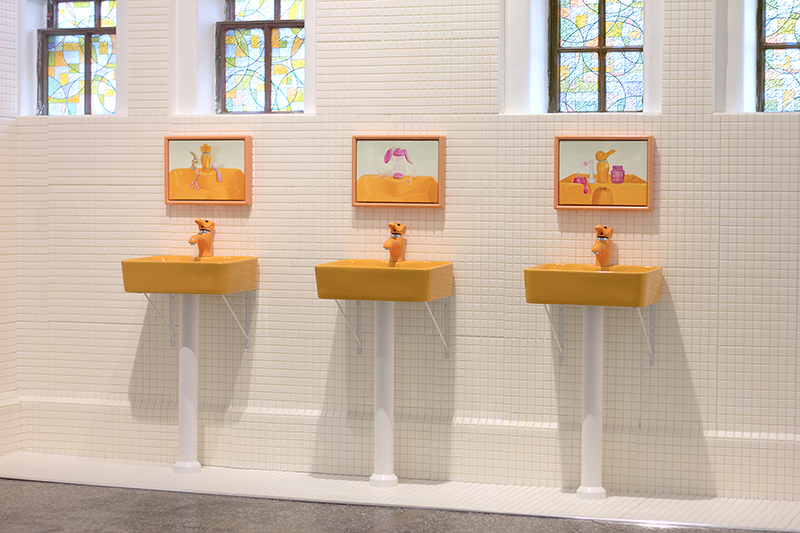
Gentle on Hands & Everything They Wash (detail), 2019, Gus Fisher Gallery.
What is the primary role of an artist? How do you describe yourself in the context of challenging people’s perspectives via your work and art?
I think all artists challenge the way we see the world in some way. I love that art can be subversive and clever but also ambiguous. It can be used for protesting against power structures and dominant ways of seeing. By using ordinary, familiar subject matter, I’d like for people to notice things around them a little more, and recognise some of the strangeness in the everyday. I like that viewers can bring so much to the work; they can have very different responses and offer new meanings to what I’m putting out there. This can keep you grounded, help you understand what your work is actually doing and inform future work.
How does your audience interact and react to the work you put out into the world?
A woman once saw one of my installations and said it strongly conjured a childhood memory for her of the front room of an older woman’s house on their street. It had glowed pink when she went inside. She said that when she spoke to her mother about this memory years later, her mother said she would never have gone into that house as a child, and that it must have been her imagination. I love that idea: a re-constructed memory of an interior that never existed.
When a young gallerist visited my studio at a time when it was at ‘peak bathroom sink’ (with collected retro basins everywhere, making it hard to move) she said she felt a sense of anxiety as she remembered her mother methodically imparting her knowledge about how to clean the bathroom, as she passed on the job to her daughter.
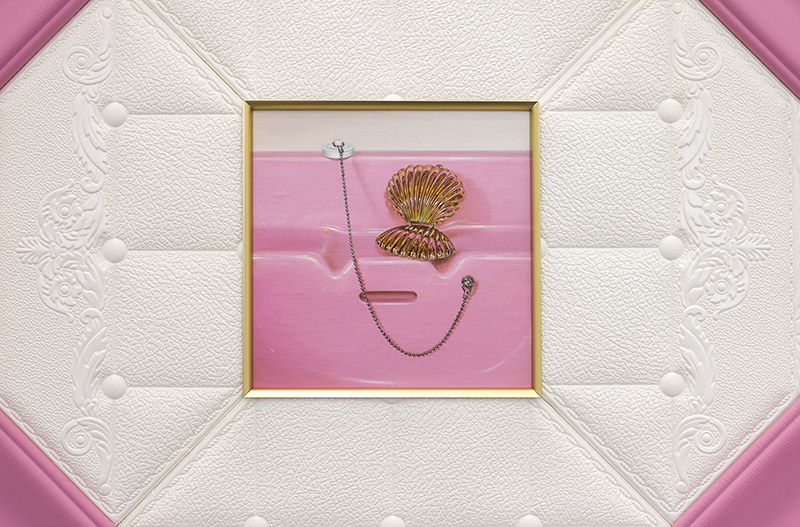
Contemporary artist Emily Hartley-Skudder. Golden Strawb Spritzer (detail), 2019.
A friend who went through art school with me, Hannah Depree, has said some significant things about my work that I couldn’t quite articulate myself:
I think it’s important work – all those intimate, personal, and sometimes painful things left unsaid in a woman’s life. Bathrooms always seem to be these pivotal places – go to clean up, make up, break down, confess, escape, get ready… all sorts of moments of significance… I don’t think men ever need to utilise them in the way that women do? It’s an interesting thought. I can’t help but think there’s a correlation between how much freedom and safety you have in public which dictates how much you will need a private outlet… For me, I identify with an underlying violence in this kind of aesthetic. The aesthetic of hard bright colors, and forceful prettiness. If that can be such a thing.
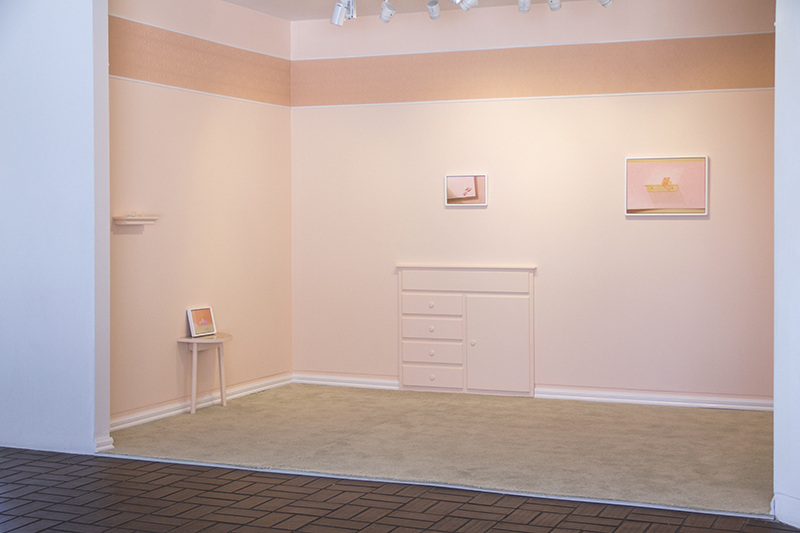
Soft Staging (install shot), Contemporary artist Emily Hartley-Skudder. 2017, Hastings City Art Gallery.
How do you balance art and life?
I’m not very good at balance… is that an artist thing?! Being an artist is how I understand myself in the world, and I am constantly observing things in the context of my practice. I find it hard to switch off – there are always emails to reply to, applications to write and research to do (let alone actually making the art). I need to work on allowing myself to have time out, so I don’t burn out. My partner, Hamish Coleman, is also an artist and I tend to ask a lot of him in terms of sounding out ideas and getting advice. I am very grateful for all his help, but sometimes I get tunnel vision with a project and it becomes all I talk about. I definitely need to work on this, so I don’t suck him into my practice completely.
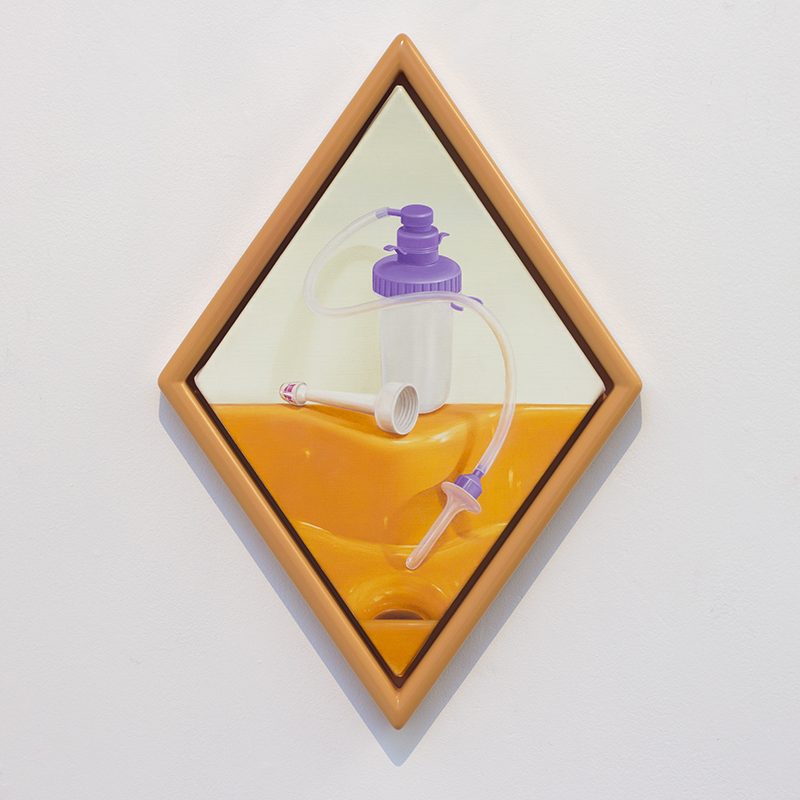
Gentle on Hands, 2019, oil on linen. Contemporary artist Emily Hartley-Skudder.
What are you looking for when you look at other artists’ work? Who are your maestros?
I like seeing things well made; artists that you can tell put a lot of effort in. Can appreciate a bit of humour, investment in an idea, good use of colour or lack of, you know – all the usual things! I like things that are totally different from my work, or things that I know I can’t do myself. I get really excited about work that is exploring similar concerns to myself, but is done in a different way.
Can be pretty critical of painting – probably because of spending so long doing it. With painting it all starts with the surface. High quality paint and linen makes a huge difference. If you don’t have the surface right it doesn’t matter what’s going on within the painting.
There are of course the heavy hitters in the art world that can’t help but inform my practice, the likes of Heim Steibach, Robert Gober and Jeff Koons. But closer to home, I look to these female artists from Aotearoa: Judy Darragh, Yvonne Todd, Eve Armstrong, Liz Maw and Erica van Zon. I’m also super excited by some artists who I actually first discovered through Instagram: Leah Guadagnoli, Gracelee Lawerence, Material Girls (collective), Tia Ansell and Esther Stewart.
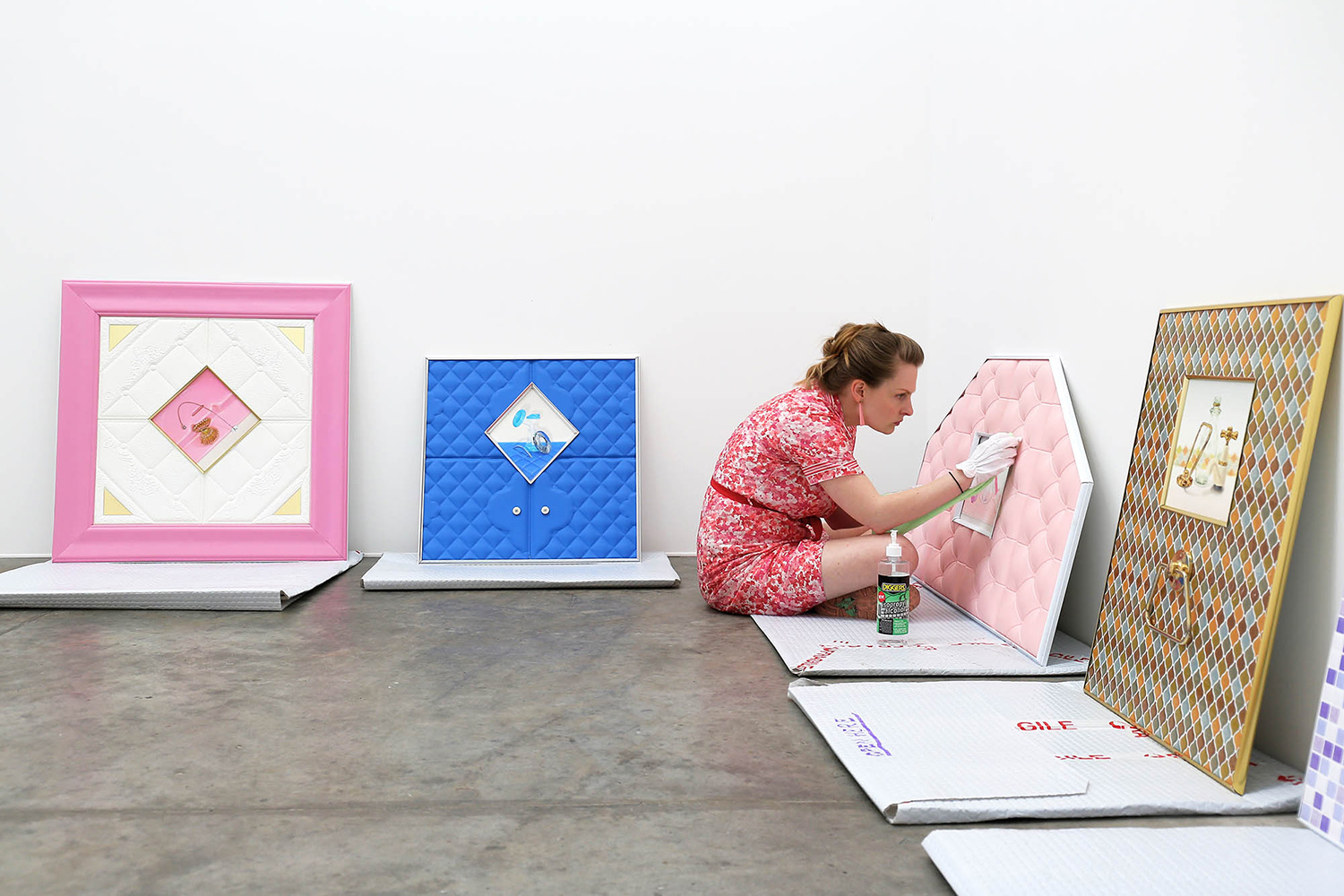
Contemporary artist Emily Hartley-Skudder. Installing ‘Lollygagger’. Picture by Vicki Piper.
What are you working on now? What’s coming next season?
I’m working on a project with curator Lauren Gutsell of Dunedin Public Art Gallery, responding to eight works from the gallery’s contemporary collection. I’ll be creating immersive installations around them and my paintings will be hanging out amongst them too. Think retro carpet, lino, floral wallpaper and a red bathtub. It’ll be my biggest project to date so stay tuned. There’s some epic works in their collection that I’ll be working with, so no pressure right?! This opens mid February next year, so it’s going to be a busy summer.
Before you go – you might like to browse our Artist Interviews. Interviews of artists and outliers on how to be an artist. Contemporary artists on the source of their creative inspiration.











Add Comment